Marvel Studios’ WandaVision are many shows within a show that exists within a New Jersey fictional town covered in a grief-stricken superhero’s magic. That is a lot to take in. But when all the puzzle pieces come together, at the last episode of its nine-episode limited series, it feels great.
That is a lot to take in. But when all the puzzle pieces come together, at the last episode of its nine-episode limited series, it feels great. To truly appreciate the greatness that is WandaVision, one has to find a seat belt, strap in and immerse themselves in the many Easter eggs and clues speckled throughout the show while traveling through several decades of sitcom television.
What does it all mean?
Wanda Maximoff (Elizabeth Olsen) is a villain-turned-hero from the Avengers movies. Throughout all the movies she appears in, we only know her as Wanda, a young woman with magical powers hailing from the fictional country of Sokovia. Wanda and her brother Pietro Maximoff (Aaron Taylor-Johnson), also known as Quicksilver because of his super-speed, were orphaned after their parents were killed by bombs manufactured by Stark Industries as part of an American missile strike. Stark Industries is the company run by Tony Stark (Robert Downey Jr.), also known as Iron Man. In Avengers: Age of Ultron, Wanda and Pietro initially worked alongside the villainous genocidal robot Ultron. Before she ultimately turned on Ultron and assisted in his defeat, Pietro is killed. In Captain America: Civil War, Wanda accidentally destroys a building in the Nigerian city Lagos full of Wakandan civilians. Then in Avengers: Infinity War, she was forced to kill the love of her life: Vision (Paul Bettany), a synthezoid member of Avengers. And when the villain Thanos reversed time to reverse it, he killed Vision for a second time. Wanda suffered a series of losses within a relatively short period of time, but didn’t appear to have enough time to process her mounting grief.
Shortly before they were killed, Wanda’s parents introduced to their children classic American sitcom television from the 1950s and 60s. These cheery and bubbly sitcoms served as a safe, pleasant and fun contrast to the wartown streets of Sokovia just outside their apartment. Watching these shows were significantly influence her psychosis as she inadvertently used her magic to create a town and brainwash citizens into conforming to her synthetic sitcom life with Vision inexplicably by her side.
or the start of WandaVision, each episode was a throwback to class sitcoms that proceeded in chronological order by the decade. For example, the first episode was set in the 1950s and heavily inspired by shows like The Dick Van Dyke Show and I Love Lucy. The second episode would take place in the 1960s and inspired by shows like Bewitched and I Dream of Jeannie. As the decades go on, the curtain is pulled back a little more until viewers realize nothing is what it seems. Adding to the mystery is a self-described “nosy neighbor” named Agnes (Kathyrn Hahn), who seemed extremely insistent on being a part of Wanda’s life. We later learn Agnes was short for Agatha Harkness, a witch from Salem, Massachusetts who desired Wanda’s “chaos magic” and attempted to harness it because she’s evil.
Meanwhile, Wanda also has to deal with S.W.O.R.D., an American extra-governmental intelligence agency seeking to destroy her. And one of their agents, Monica Rambeau (Teyonah Parris), is looking to help Wanda, believing Wanda had no political agenda or inclination toward destruction. After confronting S.W.O.R.D., Monica was relieved of duty and left to help Wanda with FBI agent Jimmy Woo (Randall Park) and astrophysics doctor Darcy Lewis (Kat Dennings).
Confused? If so, that’s completely understandable.
If you’re a Marvel true believer, chances are you’ve watched most of the Marvel Cinematic Universe movies to follow all the events preceding the show and better appreciate all the references. If you’ve read the comics, you may recognize some of the references but not expect some of the plot twists that deviate from the source material. If you’re not familiar with the comics or the movies, WandaVision will likely overwhelm you with a lot of moving parts converging at one point and leaving you with a lot of questions.
But that’s also the beauty behind WandaVision. This is a show that is meant to be rewatched several times. There are a lot of references to Marvel titles that are worth watching and rewatching. Having that knowledge makes the emotional payoffs a lot more breathtaking and powerful. Eventually, through the chaos and confusion the show seemingly embodies in every episode, the clues begin to appear. Those seemingly random commercial breaks begin to make sense as they allude to pivotal moments in Wanda’s past while foreshadowing events.
Above all else, WandaVision is a show about grief, what grief is and how it’s processed. Sure, the story plays out a narrative that serves as a thread connecting the previous Marvel Cinematic Universe movies into a new phase of films we haven’t seen yet. But through vivid and avant garde storytelling, WandaVision shows it’s possible to accept grief even if it seems insurmountable – and a surprising amount of fun can be found from going through the show’s journey.
Watch all the episodes of WandaVision exclusively on Disney+. Images courtesy of Disney/Marvel Studios.

Related Posts
February 12, 2022
Netflix’s Cobra Kai Strikes Hard With a New Generation
Cobra Kai on Netflix is widely…



